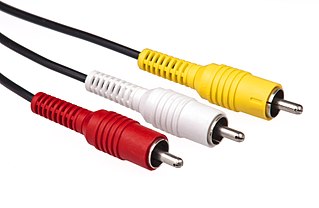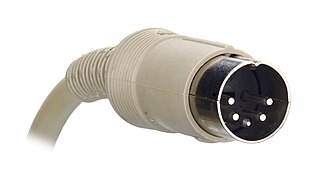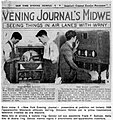
The RCA connector is a type of electrical connector commonly used to carry audio and video signals. The name RCA derives from the company Radio Corporation of America, which introduced the design in the 1930s. The connector’s male plug and female jack are called RCA plug and RCA jack.

Luxor was a Swedish home electronics and computer manufacturer located in Motala, established in 1923 and acquired by Nokia in 1985. The brand name is now owned by Turkish company Vestel and is used for televisions sold in the Swedish market.

The DIN connector is an electrical connector that was standardized by the Deutsches Institut für Normung (DIN), the German Institute for Standards, in the mid 1950's, initial with 3 pins for mono, but when stereo connections and gear appeared in late 1950's, versions with 5 pins or more were launched. The male DIN connectors (plugs) feature a 13.2 mm diameter metal shield with a notch that limits the orientation in which plug and socket can mate. The range of DIN connectors, different only in the configuration of the pins, have been standardized as DIN 41524 / IEC/DIN EN 60130-9 ; DIN 45322 ; DIN 45329 / IEC/DIN EN 60130–9 ; and DIN 45326 / IEC/DIN EN 60130-9.

Audio equipment refers to devices that reproduce, record, or process sound. This includes microphones, radio receivers, AV receivers, CD players, tape recorders, amplifiers, mixing consoles, effects units, headphones, and speakers.

Heathkit is the brand name of kits and other electronic products produced and marketed by the Heath Company. The products over the decades have included electronic test equipment, high fidelity home audio equipment, television receivers, amateur radio equipment, robots, electronic ignition conversion modules for early model cars with point style ignitions, and the influential Heath H-8, H-89, and H-11 hobbyist computers, which were sold in kit form for assembly by the purchaser.
Telefunken was a German radio and television producer, founded in Berlin in 1903 as a joint venture between Siemens & Halske and the Allgemeine Elektrizitäts-Gesellschaft (AEG) . Prior to World War I the company set up the first world wide network of communications and was the first in the world to sell electronic televisions with cathode ray tubes, in Germany in 1934.
Kenwood is a Japanese brand of consumer electronics. It has been owned by JVCKenwood since October 2011, when Kenwood Corporation merged with JVC. Kenwood manufactures audio equipment such as AM/FM stereo receivers, cassette tape decks/recorders, amateur radio (ham) equipment, radios, cellular phones, speakers, and other consumer electronics.
Lafayette Radio Electronics Corporation was an American radio and electronics manufacturer and retailer from approximately 1931 to 1981, headquartered in Syosset, New York, a Long Island suburb of New York City. The company sold radio sets, Amateur radio (Ham) equipment, citizens band (CB) radios and related communications equipment, electronic components, microphones, public address systems, and tools through their company owned and branded chain of retail outlets and by mail-order.

ReVox is a brand name, registered by Studer on 27 March 1951 for Swiss audio equipment.

Pye Ltd was an electronics company founded in 1896 in Cambridge, England, as a manufacturer of scientific instruments. The company merged with EKCO in 1960. Philips of the Netherlands acquired a majority shareholding in 1967, and later gained full ownership.
Denon is a Japanese electronics company dealing with audio equipment. The Denon brand came from a merger of Denki Onkyo and others in 1939, but it originally started as Nippon Chikuonki Shoukai in 1910 by Frederick Whitney Horn, an American entrepreneur.
Armstrong Audio, originally called Armstrong Wireless and Television Ltd. was a British manufacturer of radios and other audio equipment based in London, England. Founded by Claude Charles Jackson in 1932.
Optonica was a subdivision of Japanese electronics manufacturer Sharp that made high-end hi-fi products systems.

Fisher Electronics was an American company specialising in the field of hi-fi electronics. The company and the name was bought by Japanese electronics conglomerate Sanyo in 1975.
Technics is a Japanese brand name of Panasonic for audio equipment. Since 1965, Panasonic has produced a variety of hi-fi and audio products under the brand name, such as turntables, amplifiers, radio receivers, tape recorders, CD players, speakers, and digital pianos. Technics products were available for sale in various countries. The brand was originally conceived as a line of high-end audio equipment to compete against brands such as Nakamichi.
Carad was a brand of the Ets. G.L. Carpentier, a small Belgian electronics manufacturer located in Kuurne, near Kortrijk. It existed from 1925 to 1975. At the height of its activities around 1970, the company employed about 400 people.
The following timeline tables list the discoveries and inventions in the history of electrical and electronic engineering.
Radio-electronic industry is a part of the machine-building industry, which in planning has been classified since 1968 separately from the radio industry, electronic industry, and the subdivision of instrument making. In the official reporting statistics license applications are submitted only in the categories of "devices, means of automation and computer technology" and "radio receivers, radios, TVs and household recorders", which does not cover all products.

Radiotechnique (RT) was a French electronics company that made radio transmitting and receiving vacuum tubes, and later more advanced components such as integrated circuits and solar panels. At first it was a subsidiary of the French Compagnie générale de la télégraphie sans fil (CSF). Later it became a subsidiary of Philips of the Netherlands. The company expanded after World War II, moving into television and electronics, including photovoltaics and printed circuits, and in 1979 had about 15,000 employees. Later it lost market share, went through various restructurings, was sold in 1998 and went bankrupt in 2002.

Howard Philip Ladd (1921-2015) was an electrical engineer, inventor, marketer, entrepreneur and bank founder. Ladd was a pioneering giant in American and international consumer audio and video electronics.
























